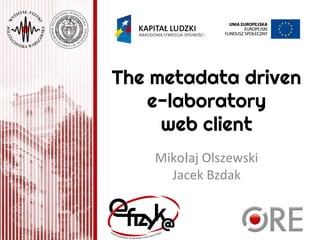
The metadata driven e-laboratory web client
- 1. The metadata driven e-laboratory web client Mikołaj Olszewski Jacek Bzdak
- 2. Outline 1. Idea 2. Metadata driven laboratory 3. Protocol Details 4. Demo 5. Benefits
- 4. Introduction • SILF is a remote laboratory developed in a project: “e-physics - the multimedia environment of teaching physics for upper secondary schools” • We are to develop 13 remote experiments in 3 years • We wanted to decrease per-experiment development costs
- 5. SILF characterisation • Experiment servers written in Python • Experiment client is written in Coffeescript, and requires only a browser to work • Communication is done via the XMPP protocol • We use XMPP moderation tools • Every experiment session is done via XMPP group chat room
- 7. Detailed view of SILF architecture
- 8. Terminology
- 9. Components - before • Experiment server • One per experiment, though we have some driver reuse • Experiment client • Previously we had a plugin architecture, each experiment had a client plugin • Messaging server • One per laboratory
- 10. What if we had single client? • 50% less work on experiment • Yet, much more work on the infrastructure • Simplified deployment • Client updated without any changes to the WWW server • Free lunches • Updates to the client are automatically visible in all the experiment
- 11. Metadata driven laboratory The conclusion...
- 12. Metadata driven laboratory • User gets a description of the experiment from the experiment server • HTML5 Client is responsible for rendering GUI according to the description
- 13. Why Web GUI? • HTML5 powerful enough • Real-time communication via websockets • Works everywhere - everyone has a browser • but not (for example) Windows • works on mobile devices - responsive layout • Social networks seamless integration • It is simple and natural for modern people • Easy to upgrade - SaaS model
- 14. Example experiment session • Experiment modes - way to decrease inter control dependences • Experiment description can be different for each mode
- 15. Currently supported metadata • List of modes • Controls • label • type • validations • Results • name • method of display • It’s enough
- 16. Protocol details Let’s see how it works underneath...
- 17. Protocol details • XMPP dialect • 100% XMPP compliant! • <labdata> in group chat message • Action defined by namespace • Types: query, result, error • Various content in JSON Protocol documentation
- 18. Experiment conversation 1. Mode selection 2. Input validation 3. Session start 4. Incoming results 5. Session ends 6. Experiment ends or go to 1 Conversation details
- 19. Mode selection USER <labdata xmlns="silf:mode:get" id="query1" type="query" /> Experiment <labdata xmlns="silf:mode:get" id="query1" type="result"> { "lead": { "label": "Ołów", "description": "Badanie osłabienia w ołowiu", "order" : "1" } }</labdata>
- 20. Mode description • label - human readable name • description human readable • unique id - name of the mode (machine readable)
- 21. Mode setting USER <labdata xmlns="silf:mode:set" id="query2" type="query"> {"mode": "default"} </labdata> Server <labdata xmlns="silf:mode:set" id="query2" type="result"> GUI description </labdata>
- 22. Experiment metadata { "experimentId": "urn:uuid:a12e6562-5feb-4046-b98f-d8c40ca1609c", "mode": "aluminium", "settings": { "acquisition_time": {...}, "light": {...} }, "resultDescription": { "time_left": {...}, "chart": {...} } } experiment settings results / outputs description
- 23. Control properties • name - machine readable and unique id • label - human readable • type - type of the value (int, timedelta) • validations - bounds to values
- 24. Output field description • name - of the data source • type - data type • class - styling • metadata - human readable metadata
- 25. Settings validation USER <labdata xmlns="silf:settings:check" id="query3" type="query"> { "acquisition_time": {"value": 150, "current": true}, "light": {"value": false, "current": false} } </labdata> SERVER <labdata xmlns="silf:settings:check" id="query3" type="result"/> or error message (omitted)
- 26. Series start USER <labdata xmlns="silf:series:start" id="query4" type="query"> {"acquisition_time": {"value": 150, "current": false} … }</labdata> Experiment <labdata xmlns="silf:series:start" id="query4" type="result"> { "metadata": {"label": "Czas pomiaru 90s."}, "initialSettings": { "acquisition_time": {"current": false, "value": 90}, "light": {"current": false, "value": false} }, "seriesId": "urn:uuid:6bd8a024-5a8b-4f04-be84-76dcad89d89f" } </labdata>
- 27. Series start data • metadata - human readable metadata • seriesId - unique series id (needed for storage and retrieval of data) • initialSettings - settings that were sent by the user to initiate series
- 28. Results Sent by the server when ready <labdata xmlns="silf:results" id="query5" type="result"> { "chart": { "value": [[1, 1234], [5, 321]], "pragma": "append" }, "time-left": { "value": [1], "pragma": "transient" } }</labdata> No response needed
- 29. Results • name of result block • value - value • pragma - controls data storage and presentation
- 30. End of series Series ends when: • Experiments finishes the measurements • Operator stops the series • Timeout has occured • Messages are slightly different for each case USER <labdata xmlns="silf:series: stop" id="query6" type=" query"/> Server <labdata xmlns="silf:series: stop" id="query6" type=" result"/>
- 31. End of experiment Experiment ends when: • Operator stops the experiment • Timeout has occured (experiment idle for too long) • Messages are slightly different for each case USER <labdata xmlns="silf: experiment:stop" id="query7" type="query"/> Server <labdata xmlns="silf: experiment:stop" id="query7" type="result"/>
- 32. Protocol • That is all • Less than 10 message types • Yet a fully operational laboratory
- 33. Demo That’s what tiggers do best...
- 34. Benefits • There is one single client • Existing experiments "get features" as we develop the client • Easy to develop automatically controlled experiment (working in showcase mode) • Easy (for example) to build Android client • Possible to create server in C/C++/Java/your favorite language
- 35. Epilogue • Whole framework is open-sourced • Rest of laboratory is being open-source • Refer to the documentation for details • See also our repositories • This presentation: http://tnij.org/silf|vu2014 Thanks for your attention
